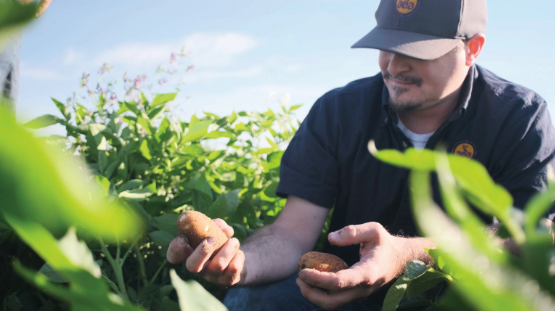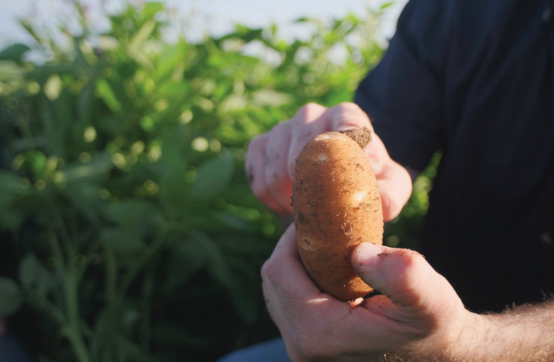
Reducing nitrogen to improve soil and plant health
Potato health and marketability are constants at the forefront of growers’ minds. Whether it’s high bruise-free percentages and high yields or the reduction of roadmapping in colored potatoes, potato health and soil health go hand in hand.
While there’s a historical approach of farming culture that developed around treating symptoms, boosting soil health and reducing the application rate of nitrogen (N) on a field could increase overall improvements.
But the reduction in N use can be a scary proposition, particularly if there is conflicting information and a questioning of long-held farming beliefs.
“There is very little attention given to the idea that too much nitrogen is a cause of problems,” said Kevin Tulley, farm consultant at Advancing Eco Agriculture. “Both nitrogen and potassium overapplication cause some of the biggest problems for farmers.”
What happens when too much nitrogen is applied, explained Tulley, is that plants grow in an overly vegetative way, instead of in a reproductive fashion. And when they are grown in that way — with very high levels of N — they can develop weak, watery cells that are more susceptible to disease.
“The plant can’t process it all,” said Tulley, “so then you have these unprocessed forms of nitrogen floating in the sap, specifically nitrate and ammonium, and that’s what brings in pests and disease.”
This is what can attract aphids and mites, and can make plants susceptible to mildew. But when nitrogen is more accurately managed for the plants’ actual needs, the nitrate and ammonium are processed into amino acids, peptides and proteins. When all that nitrogen is converted, the plants are inedible to these sucking and chewing insects, said Tulley.
Tulley has seen reduced N in a field yield amazing results, sometimes with half or less than half of traditional recommendations. When used in combination with applied micronutrients, insect infestations and the need for pesticides were reduced.
“There can be pests all around, and in all the pivots, but no pests in these fields. It’s shocking,” he said.
Sap analysis has been available for a number of years, but it’s still new enough to the industry that it isn’t standard practice. It is, however, gaining traction as a more accurate method to determine the needs of the plant. Tissue analysis is still the norm, but in comparison, it paints a more historical view of what’s been nutritionally built into the leaf prior, in addition to what’s currently present.
A sap analysis is more akin to a blood test, providing a view of what’s running through the plant now, with an up-to-date, real-time data point.
“We use sap analysis to realistically determine what sort of nitrogen applications are needed, because it’s going to be different from field to field and crop to crop,” Tulley said. “There isn’t a magic number of what the right amount of nitrogen is. We test, the plants tell us, and we go from there.”
Another significant piece of this puzzle are the micronutrients used to process the nitrate and ammonium into proteins, and sap analysis is also used to determine which micronutrients are missing so they can be supplied.

Changing the tradition
Reevaluating historical practices can have a positive effect for growers.
Take, for example, pesticide sprays. If growers have the resources, it’s better to spray reactively based on scouting rather than prophylactically based on the calendar, said Tulley.
So, what would a season look like? A biological application would follow a fall fumigation to reestablish biology. Then, at planting, there would be a reduction in nitrogen with a stronger biological planter band accompanied by a biological seed coat.
“Growers can still do the biological planter band even if they’re using mancozeb or other fungicides on the seed,” said James Dunlop, Advancing Eco Agriculture consultant. “The biological planter band will still be effective.”
Combining biology with chemical sprays
If the introduction of biology is followed up with something like a broadleaf herbicide or fungicide, how are these two methods supposed to work hand in hand?
It’s a legitimate question, said Tulley, and in his experience, the workaround has been to follow up chemical sprays with the reintroduction of biology.
For potato growers, the reintroduction of biology often translates into stronger, healthier potatoes, which can increase bruise-free percentages. When there’s been too much applied N contributing to those leaky cells, potatoes become less dense and less durable.
Importance of calcium
Both Tulley and Dunlop stress the importance of calcium (Ca) in potatoes, and if there is an over application of potassium, calcium uptake will be inhibited.
“If there’s a ton of potassium in the soil, the plant will uptake that instead of the calcium,” said Tulley. “Just like nitrogen, potassium contributes to vegetative-dominant growth.”
Calcium is important for stronger cells early in the potato growth cycle, as cell walls and membranes require high levels of calcium. If the soil environment supports the uptake of calcium, potatoes will make more cells, allowing them to be firmer, denser and less prone to bruising.
The potassium-calcium relationship is one of the most important ones Tulley and Dunlop come across, and this is true for a lot of different crops.
“We typically want a lot of calcium early on in the season, like with tuber initiation, but then after that, when we’re bulking, then it’s okay to have some potassium out there,” said Dunlop.
A lot of this has to do with timing, and there is often plenty of nitrogen available for young plants because bacteria are still working in the soils over the winter period. Sap analysis can accurately confirm (or refute, depending on the field) a farmer’s ability to reduce upfront nitrogen.
Underneath all these systems is an overall goal to increase yield and ROI while ximproving soils and plant health. It’s a ripple effect, where growers can take money that would have been spent on nitrogen and apply it toward soil biological inoculants and micronutrients that improve overall plant health.
“We try to farm in a way that supports the biological system,” Tulley said.














